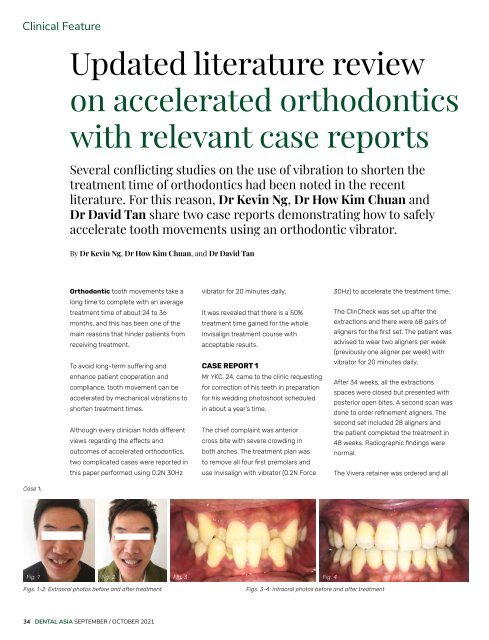Dental Asia September/October 2021
For more than two decades, Dental Asia is the premium journal in linking dental innovators and manufacturers to its rightful audience. We devote ourselves in showcasing the latest dental technology and share evidence-based clinical philosophies to serve as an educational platform to dental professionals. Our combined portfolio of print and digital media also allows us to reach a wider market and secure our position as the leading dental media in the Asia Pacific region while facilitating global interactions among our readers.
For more than two decades, Dental Asia is the premium journal in linking dental innovators and manufacturers to its rightful audience. We devote ourselves in showcasing the latest dental technology and share evidence-based clinical philosophies to serve as an educational platform to dental professionals. Our combined portfolio of print and digital media also allows us to reach a wider market and secure our position as the leading dental media in the Asia Pacific region while facilitating global interactions among our readers.
Create successful ePaper yourself
Turn your PDF publications into a flip-book with our unique Google optimized e-Paper software.
Clinical Feature<br />
Updated literature review<br />
on accelerated orthodontics<br />
with relevant case reports<br />
Several conflicting studies on the use of vibration to shorten the<br />
treatment time of orthodontics had been noted in the recent<br />
literature. For this reason, Dr Kevin Ng, Dr How Kim Chuan and<br />
Dr David Tan share two case reports demonstrating how to safely<br />
accelerate tooth movements using an orthodontic vibrator.<br />
By Dr Kevin Ng, Dr How Kim Chuan, and Dr David Tan<br />
Orthodontic tooth movements take a<br />
long time to complete with an average<br />
treatment time of about 24 to 36<br />
months, and this has been one of the<br />
main reasons that hinder patients from<br />
receiving treatment.<br />
To avoid long-term suffering and<br />
enhance patient cooperation and<br />
compliance, tooth movement can be<br />
accelerated by mechanical vibrations to<br />
shorten treatment times.<br />
Although every clinician holds different<br />
views regarding the effects and<br />
outcomes of accelerated orthodontics,<br />
two complicated cases were reported in<br />
this paper performed using 0.2N 30Hz<br />
vibrator for 20 minutes daily.<br />
It was revealed that there is a 50%<br />
treatment time gained for the whole<br />
Invisalign treatment course with<br />
acceptable results.<br />
CASE REPORT 1<br />
Mr YKC, 24, came to the clinic requesting<br />
for correction of his teeth in preparation<br />
for his wedding photoshoot scheduled<br />
in about a year’s time.<br />
The chief complaint was anterior<br />
cross bite with severe crowding in<br />
both arches. The treatment plan was<br />
to remove all four first premolars and<br />
use Invisalign with vibrator (0.2N Force<br />
30Hz) to accelerate the treatment time.<br />
The ClinCheck was set up after the<br />
extractions and there were 68 pairs of<br />
aligners for the first set. The patient was<br />
advised to wear two aligners per week<br />
(previously one aligner per week) with<br />
vibrator for 20 minutes daily.<br />
After 34 weeks, all the extractions<br />
spaces were closed but presented with<br />
posterior open bites. A second scan was<br />
done to order refinement aligners. The<br />
second set included 28 aligners and<br />
the patient completed the treatment in<br />
48 weeks. Radiographic findings were<br />
normal.<br />
The Vivera retainer was ordered and all<br />
Case 1:<br />
Fig. 1 Fig. 2 Fig. 3 Fig. 4<br />
Figs. 1-2: Extraoral photos before and after treatment<br />
Figs. 3-4: Intraoral photos before and after treatment<br />
34<br />
DENTAL ASIA SEPTEMBER / OCTOBER <strong>2021</strong>


















